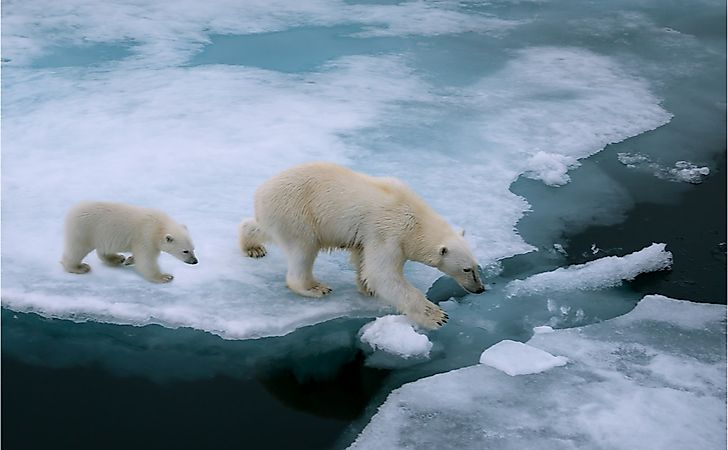How Is The Polar Bear Adapted To Its Environment?

Polar bears, also known as Ursus maritimus, are large carnivorous mammals native to the region lying within the Arctic Circle, which includes the Arctic Ocean and its surrounding seas and landmasses. An adult male of a polar bear, also known as boar, weighs approximately 772 to 1,543 pounds. The female polar bear, also known as a sow, weighs about half the weight of the male. Polar bears are the largest terrestrial carnivores living in the world today. The species is closely related to the brown bear but has evolved to inhabit a narrow ecological zone. Most polar bears are born on land, and they spend a greater part of their lives on sea ice, and that is why they are also known as marine bears. Seals are their preferred meal and they hunt them from the edges of sea ice shelves.
According to the theory of evolution, only the fittest survive. The polar bear has also developed several specialized features that allow it to survive and thrive in the extremely cold environment of its habitat. These adaptations have been listed below:
Unique Adaptations Of Polar Bears
a) Paws And Claws To Walk On Ice
The environment where the polar bears are found do not have much vegetation or plants, and therefore these animals have evolved to have unique claws different from that of the brown bears. The claws which were long and suitable for digging up vegetation in the case of brown bears evolved to become shorter and more convenient for walking on ice. They also have sticky bumps known as papillae in the paws that offer a firm grip on ice. Their paws are large, which is ideal for roaming the Arctic. They measure about 11.81 inches across, and this assists them to tread on thin ice sheets without sinking by distributing their body weight across a larger area. When they are walking on fragile ice sheets, the bears extend their legs wide apart, and they lower their bodies to further distribute their body weight. When they are swimming, the forepaws serve as large paddles while the hind paws act as rudders.
b) White Fur
The fur of the polar bears is made of dense insulating underfur, which is topped by another layer of guard hair that varies in length. The fur insulates the body and limits heat loss. It has been found that polar bears, especially male adults, quickly overheat when they run because of this unique adaptation. Interestingly, the fur of a polar bear is not white; their hair does not have pigments. They are transparent, and they have a hollow-core which reflects and scatters visible light, just like what happens with snow and ice. This adaptation protects the bear against overheating mainly in summer when sunlight is intensive. The skin of the polar bears is black and underneath lies a thick fat layer that can reach 4.49 inches and act as an insulator.
c) Low Surface Area To Volume Ratio
This is one of the anatomical adaptations of the polar bears. In comparison to other species of bears, polar bears have small extremities with a stocky build and proportionally short legs. This adaptation ensures that there is less surface area to lose heat. This is a universal adaptation of animals inhabiting cold environments. However, due to this adaptation, these animals are not able to cope with warm temperatures because they quickly overheat.
d) A Highly Specialized Diet
Polar bears have developed a unique physiological adaptation to be able to consume a high-fat diet. They primarily feed on the blubber from the seals they catch, which is mainly fat and acts as their source of energy. Other animals will not survive if they consume such large amounts of fats in their meals. Grown-up bears eat only the blubber, but the young ones who are still growing also eat the meat which is a source of protein. There is another significant advantage in consuming fat and not protein. This feeding habit does not require the animal to excrete excess nitrogen as a byproduct of protein, which would come out in the form of urea present in urine. This process would require much water to be lost. Although the bear could consume ice or snow to replace lost water, this would mean the bear have to use more energy to warm up again. Therefore, consuming fat is an efficient way of conserving energy.
e) Ocular Adaptations
Polar bears have also developed ocular adaptations to survive in their extreme environment. They have a high concentration of rod cells in their eyes which equips them with powerful vision in the dark. This adaptation also helps them to see in the water while they are swimming.
f) Excellent Swimmers
Polar bears are efficient swimmers and this allows them to move in search of new sea ice masses in search of seal colonies where they can have their meals.
Threats And Conservation
Estimation of polar bear populations is an arduous task due to their remote habitat. However, estimates made by IUCN suggest that about 22,000 to 31,000 polar bears survive in the wild as of 2015. The species is listed as vulnerable on the IUCN Red List and their populations are expected to dwindle by more than 30% over the next three generations. Climate change, pollution, oil and gas exploration in their habitat, and conflict with shipping vessels are the biggest threats to this species.











